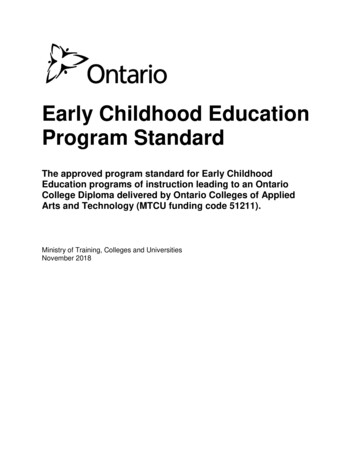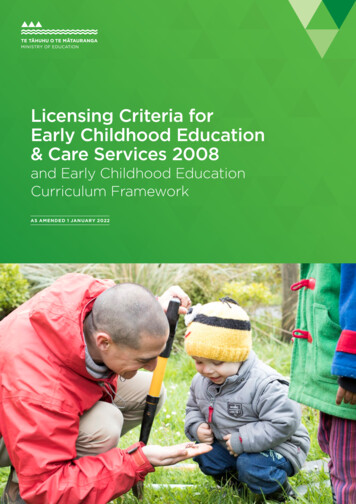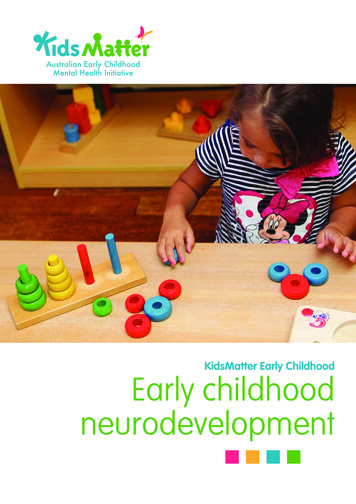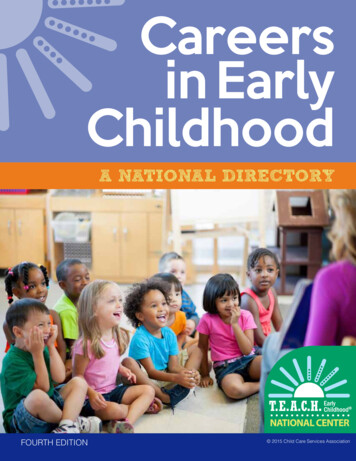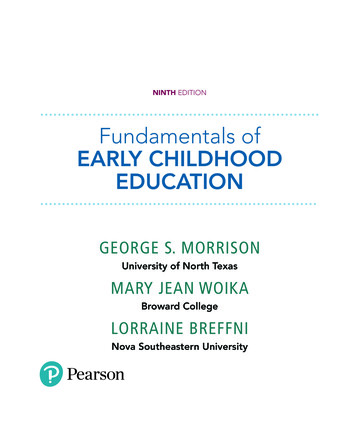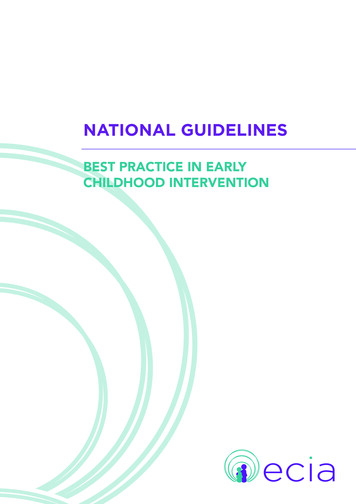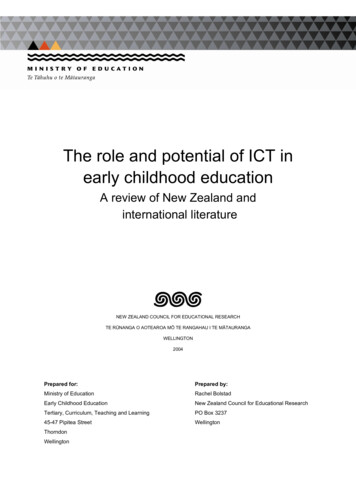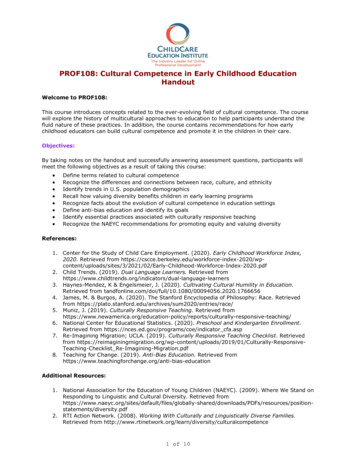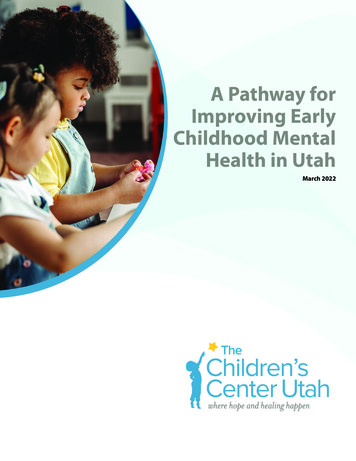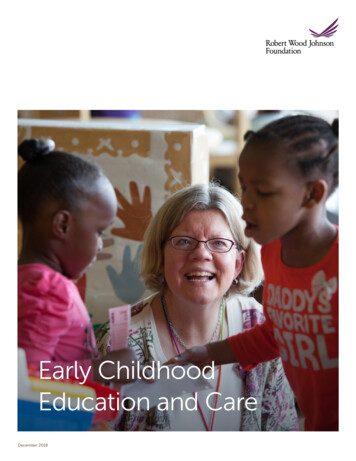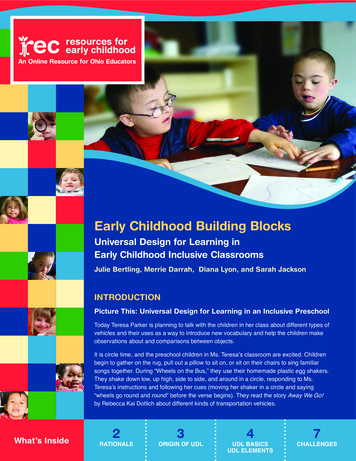
Transcription
February 2016Inclusive PracticesIn Early Childhood Special Education/Early Intervention:Selected Links to Online Resources Promoting Evidence-Based PracticesCalifornia Department of Education, Child Development s.htmlInclusion Works! Creating Child Care Programs That Promote Belonging for Childrenwith Special Needs. This training includes PowerPoint, participant handouts, and trainernotes.Child and Family Studies Research Programs, Thomas Jefferson Universityhttp://jeffline.tju.edu/cfsrpThe CFSRP supports research projects devoted to developing evidence based trainingprograms and models to identify and implement best practices for families, their infants,toddlers, and young children with disabilities. Projects address assistive technology,participation-based services, training for early intervention providers, and trainingmodules on inclusive childcare.See, for example, Philadelphia Inclusion Network Training Programs: Promoting theInclusion of Infants and Young Children with Disabilities in Child Care erials-pin1.htmlDivision for Early Childhood (DEC) of the Council for Exceptional Children (CEC) Position Statements and Papers- See for example, Joint Position Statement of theDivision for Early Childhood and the National Association for the Education ofYoung Children (2009) available in English/Spanish.http://www.dec-sped.org/papers DEC Recommended Practices- download the newly updated Practices andsupporting Glossary and view 3 brief video icesECTA Center: The Early Childhood Technical Assistance Centerhttp://ectacenter.org/The ECTA is funded to improve early childhood systems, practices and outcomes. Onearea of emphasis is Inclusion in Least Restrictive n/default.asp See for example: 2014-2015 Inclusion of Young Children with Disabilities Webinar Series OSEP Reporting Requirements Tools for Understanding EC-LRE 2014 Preschool Inclusion Fact SheetsØ Barton, E. E. & Smith, B. J. (2014). Brief fact sheet of research onpreschool inclusion. Pyramid Plus: The Colorado Center for SocialEmotional Competence and Inclusion. Denver, CO. University of KansasKansas Inservice Training System (KITS)www.kskits.org u kskits@ku.edu1
February 2016 Ø Barton, E. E. & Smith, B. J. (2014). Fact sheet of research onpreschool inclusion. Pyramid Plus: The Colorado Center for SocialEmotional Competence and Inclusion. Denver, CO.Ø Smith, B. J. (2014). IDEA Provisions Supporting Preschool Inclusion.School of Education on and Human Development, University ofColorado, Denver.Ø Strain, P. (2014). Inclusion for Preschool Children with Disabilities:What We Know and What We Should Be Doing. University ofColorado, Denver.Cate, D., Diefendorf, M.L., McCullough, K., Peters, M., & Whaley, K.(2010). Quality indicators of inclusive programs/practices: A compilationof selected resources designed for families, practitioners, programadministrators, researchers, and state administrators.http://ectacenter.org/ , M., Cate, D., McCullough, K., & Peters, M. (2012, April).Considerations for Making Finance Decisions to Promote PreschoolInclusion: A Toolkit.http://ectacenter.org/ pdfs/topics/inclusion/financeinclu.pdfWhaley, K., Goode, S., & deFosset, S. (2005) Selected Resources onFinancing Early Childhood Systems to Support Inclusive Options forYoung Children with Disabilities - Minibibliography.http://ectacenter.org/ pdfs/pubs/financemini.pdfFrank Porter Graham Child Development Institute at the University of NorthCarolina at Chapel Hill http://www.fpg.unc.eduFPG scientists study important issues facing young children and their families and use theinformation to enhance policy and improve practices. Researchers focus on parent andfamily support; early care and education; child health and development; earlyidentification and intervention; equity, access and inclusion; and early childhood policy.The center supports multiple projects, websites, and products. See for example FPGProjects:CONNECT: The Center to Mobilize Early Childhood Knowledge.http://community.fpg.unc.edu/Funded by the US Office of Special Education Programs, the center is developingfree web-based instructional modules for faculty and other professionaldevelopment providers focused on evidence based practices for working withyoung children with disabilities in inclusive settings. The first modules addresstopics including Embedded Interventions, Transition, Communication forCollaboration, Family-Professional Partnerships, Assistive Technology, DialogicReading, and Tiered Instruction. Modules are available in English and Spanish.The project also produced a 12-minute video Foundations of Inclusion to view ordownload from ces/videos/foundations-of-inclusion-birth-to-five University of KansasKansas Inservice Training System (KITS)www.kskits.org u kskits@ku.edu2
February 2016New in 2013 is the Foundations of Inclusion Training Curriculum, a 2-hourtraining designed for use by professional development/technical assistanceproviders in a face-to-face facilitated workshop. Facilitator’s guide, handouts,and activities can be downloaded at hildhoodInclusionNational Professional Development Center on Inclusionhttp://npdci.fpg.unc.edu/The NPDCI is funded by the US Office of Special Education Programs to create asystem of high quality, cross-agency professional development for earlychildhood personnel to support inclusion. See, for example: Quality Inclusive Practices: Resources and Landing Pads (2012)Ø Universal Design for LearningØ Assistive TechnologyØ Embedded Instruction and other Naturalistic InterventionsØ Scaffolding StrategiesØ Tiered Models of Instruction/InterventionØ Professional DevelopmentØ Models of CollaborationØ Family-Professional Collaboration The Inclusive Classroom ProfileAn Administrator’s Guide to Preschool rators-guide-preschool-inclusionThis guide was developed to help administrators who are responsible for settingup, monitoring, supporting and maintaining inclusive programs for preschoolchildren with and without disabilities. It delineates barriers and roadblocks, whileat the same time offering strategies, supports, and illustrations. The guide wasdeveloped by the Early Childhood Research Institute on Inclusion, a 5-yearnational research project that ended in 2000.Head Start Center for Inclusion http://depts.washington.edu/hscenter/This website was funded by the Office of Head Start with the goal of increasing thecompetence, confidence, and effectiveness of Head Start personnel in providing servicesto young children with disabilities. The site includes video and print resources fortrainers, administrators, and practitioners (some materials also in Spanish).Head Start National Center on Quality Teaching and Learning Disabilities – Includes Head Start policy on services to children with disabilities,FAQs, program planning, staff support and supervision issues, family tem/teaching/Disabilities Framework for Effective Practice – Resources on engaging interactions andenvironments, research-based curricula and teaching practices, ongoing child University of KansasKansas Inservice Training System (KITS)www.kskits.org u kskits@ku.edu3
February 2016 assessment, highly individualized teaching and tem/teaching/practiceSpecialQuest Preschool Inclusion Series- The SpecialQuest Multimedia trainingLibrary can be accessed from the Head Start Early Childhood Learning andKnowledge website. The SpecialQuest Preschool Inclusion Series focuses onincluding preschoolers who have disabilities in programs and settings with theirtypically developing peers. This series contains four videos. The first provides anoverview of the benefits and rationale for inclusion, as well as perspectives frommany stakeholders of what makes inclusion work. Two additional videos eachfeature a story about the successful inclusion of a child. In these videos, viewerslearn what it took for their families and their service providers to ensure that thesechildren were given the supports and opportunities they needed to flourish inprograms with their typically developing peers. The fourth video providespractical and concrete strategies for making the Individual Education Program(IEP) a process that is collaborative and that ensures inclusion, for theperspectives of family members, service providers, and administrators fromseveral service delivery systems. Five sessions, complete with facilitator scriptsand handouts, accompany the videos. ce-finder.htmlKansas Inservice Training System (KITS) www.kskits.orgKITS is a program of the Kansas University Center on Developmental Disabilities atParsons and is supported through the Kansas Department of Health and EnvironmentInfant/Toddler Services. The KITS project is designed to provide a training and resourcesystem for early intervention networks collaborative training and technical assistanceactivities on a comprehensive statewide basis. Additionally, parents and staff of agenciescollaborating with these early intervention networks, including preschool programs, areafforded the opportunity to be involved in all activities associated with the project. Thecomprehensive system is realized through four identified system components ofcollaboration/ linkages, information services, training, and technical assistance. An onlineresource center, a collaborative training calendar, technical assistance packets, web-basedtraining modules, and resources supporting inclusion in natural environments/LRE can beaccessed on the KITS website. See, for example: Itinerant ECSE Services Through Coaching and rantECSE Services Through.shtml Preschool LRE & Inclusion Resourceshttp://www.kskits.org/ta/preschool LRE Resources What Do You Do When You Get .shtml KITS Early Childhood Resource Center Online Catalogue http://kskits.org/ecrc/National Association for the Education of Young Children (NAEYC) DEC/NAEYC (April 2009) Early Childhood Inclusion: A Joint Position University of KansasKansas Inservice Training System (KITS)www.kskits.org u kskits@ku.edu4
February 2016 Statement of the Division for Early Childhood (DEC) and the NationalAssociation for the Education of Young Children (NAEYC). Chapel Hill: TheUniversity of North Carolina, FPG Child Development sitions/DEC NAEYC EC updatedKS.pdfConn-Powers, M., Cross, A., Traub, E., & Hutter-Pishgahi, L. (2006, Sept.).Universal design of early education: Moving forward for all children. Beyond thejournal: Young children on the web, PowersBTJ.pdfProject ct/Training%20Modules/Training Modules.htmlLaurie Dinnebeil and William McInerney of the University of Toledo’s Project DIRECTcreated a series of five training modules for itinerant early childhood special educationteachers interested in shifting from a model of direct service delivery to a moreconsultative itinerant service delivery model. Download an entire training module orindividual resources. See also Dinnebeil and McInerney (2011) Guide to Itinerant ECSEServices, available from Brookes Publishing or the KITS Early Childhood ResourceCenter (www.kskits.org).Pyramid Plus: The Colorado Center for Social Emotional Competence nclusion modelThe Pyramid Plus Center works to improve the social and emotional competence andinclusion of young children through the Pyramid Plus Approach: embedded inclusionpractices along the entire developmental continuum (Birth – 5 years) within the PyramidModel framework. This approach builds on the work of the Center on the Social andEmotional Foundations for Early Learning (CSEFEL), the Technical Assistance Centeron Social Emotional Interventions (TACSEI), and the SpecialQuest Approach andmaterials.SpeciaLink: The National Centre for Child Care Inclusionhttp://www.specialinkcanada.org/home en.htmlSpeciaLink’s goal is to expand the quality and quantity of opportunities for inclusion ofyoung children with special needs and their families in childcare, recreation, education,and other community settings. Resources on the best available practices supportinginclusion are provided for parents, early childhood educators and directors, researchersand policy makers across Canada, but available to anyone. See for example: SpeciaLink Early Childhood Inclusion Quality Scale (2009) SpeciaLink Child Care Inclusion Practices Profile and Principles Scales (2005)and DVDU.S. Department of Health and Human Services (HHS) & U.S. Department ofEducation (DoE) University of KansasKansas Inservice Training System (KITS)www.kskits.org u kskits@ku.edu5
February 2016U.S. Departments of HHS & DoE (2015). Policy statement on inclusion of children withdisabilities in early childhood lylearning/joint-statement-full-text.pdfThis joint policy statement advances the position of the Departments by Providing a definition of inclusion that proposes consideration of “naturalproportions” for students with all types of disabilities, mild to severe; Increasing understanding of the science supporting inclusion, from the earliestages; Highlighting legal foundations supporting inclusion; Providing specific recommendations for action at the state and local levels; and Identifying free resources to support high-quality programming and inclusion inearly childhood programs.See also: U.S. Department of Health and Human Services & U.S. Department of Education(2016). Inclusion in Early Childhood Programs—Webinar ning/inclusion/index.html Association of University Centers on Disabilities (2015). HHS/ED Joint PolicyStatement on Inclusion in Early Childhood Programs and the Role of UCEDDs.Early Intervention/Early Childhood Special Interest Group Webinar Series, May26, 2015. https://aucd.adobeconnect.com/ a1005431686/jointpolicystatement/ University of KansasKansas Inservice Training System (KITS)www.kskits.org u kskits@ku.edu6
collaboration/ linkages, information services, training, and technical assistance. An online resource center, a collaborative training calendar, technical assistance packets, web-based training modules, and resources supporting inclusion in natural environments/LRE can be accessed on the KITS website. See, for example:
